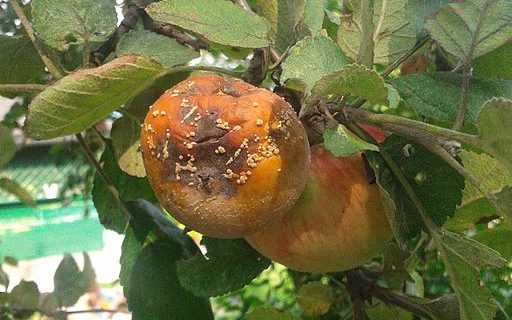Plum brown rot is a fungus that causes fruit on plum trees in the UK to rot and turn brown, visible during the summer months. It can affect a multitude of fruit trees including; pears, apples, cherries, peaches, and plums. This same fungus is also responsible for blossom wilt. Symptoms include visible signs of brown rot on the fruit and infection is spread easily by touching the fruits.

Arthuc01 CC BY-SA 3.0 via Wikimedia Commons
Fruit that has been affected by birds, pests, or bruising will be more vulnerable to an attack of brown rot. Unfortunately, in severe infections even healthy fruit will become susceptible to brown rot. The fungi Sclerotinia fructigena and S. laxa are the ones responsible for brown rot in fruit.
Jump To...
Plum Brown Rot Symptoms
It can be quite easy to spot and identify brown rot on a diseased plum, however, there are other rotting fungi such as eye rot. This can lead to some confusion when identifying brown rot specifically but most rot is dealt with in the same way.
Symptoms of brown rot are:
- Brown marks on ripe fruit.
- Concentric rings might be visible on the fruit surface.
- Infection will spread quickly, on the branches too.
- Fruit often becomes wrinkled and may drop prematurely.
Plum Brown Rot Treatment & Control
Brown rot is exasperated through the right weather conditions so it’s very important to keep on top of the disease. Attempting to keep the fruit clear of pests and birds will also help protect against brown rot.
Controlling brown rot means being very vigilant and checking the fruit for signs of plum rot. Being aware of the contribution of pests and birds will also help you keep on top of the problem.
Organic Control
Take these steps when using organic control:
- Removal of fruit as soon as you notice brown rot as it spreads from fruit to fruit, eventually affecting healthy fruit with no prior damage.
- Protecting the tree as much as possible from birds and pests as they accelerate the problem.
- Regular pruning of spurs and blossom to remove any diseased ones will help minimise the spread.
- If purchasing a plum tree, you will do best selecting a hardy one such as Czar, Jefferson, Ontario, or President.
- You need to check local guidance when disposing of large amounts of rotting fruit as each council has their own guidelines to follow.
Pesticide Control
There are no recommended pesticides to be used on brown rot in the UK.
Plum Brown Rot Biology / Lifecycle
Brown rot overwinters in the fruit shoots before releasing its spores in the spring. The rain, wind, and insects help spread infection from branch to branch, tree to tree. Wet weather favours the fungi and causes them to multiply with speed. Brown rot will spread quickly in large quantities of stored fruits so it’s important to store correctly and eat quickly.
Further Reading
Check out our comprehensive guide to plum pests and diseases for help identifying problems with your plum tree and fruit.
